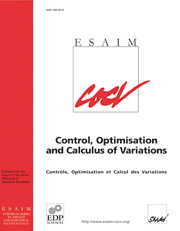Article contents
Controllability properties of a class of systems modelingswimming microscopic organisms
Published online by Cambridge University Press: 11 August 2009
Abstract
We consider a finite-dimensional model for the motion of microscopic organisms whose propulsion exploitsthe action of a layer of cilia covering its surface. The model couples Newton's laws driving the organism, considered as a rigid body, withStokes equations governing the surrounding fluid.The action of thecilia is described by a set of controlled velocity fields on the surface of the organism. The first contribution of the paper is the proof that such a systemis generically controllable when the space of controlled velocity fields is at least three-dimensional. We also provide a complete characterization of controllable systems in the case in whichthe organism has a spherical shape. Finally, we offer a complete picture of controllable and non-controllable systems under the additional hypothesis thatthe organism and the fluid have densities of the same order of magnitude.
- Type
- Research Article
- Information
- ESAIM: Control, Optimisation and Calculus of Variations , Volume 16 , Issue 4 , October 2010 , pp. 1053 - 1076
- Copyright
- © EDP Sciences, SMAI, 2009
References
- 5
- Cited by


